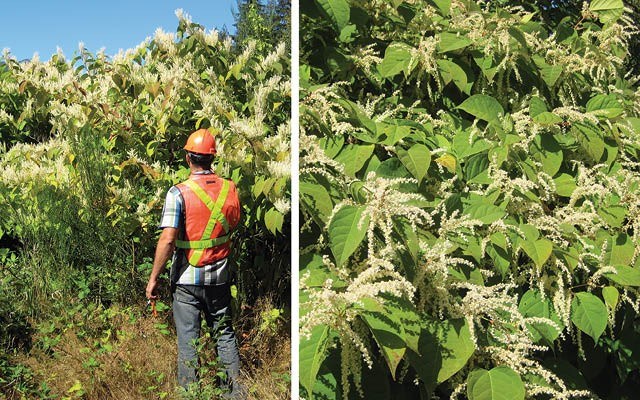An alien invasion is likely the only way to bring about world peace. Humanity would band together at the imminent threat, lay aside their issues with each other and instead, fight the invaders side-by-side.
This is what I was thinking as Rob Hughes and Sam Cousins crouched down, guns in hand, in a thicket in Squamish. The thicket was dense with Japanese knotweed.
This alien species, from Asia, was brought to B.C. as a garden ornamental and promptly upgraded to the classification of invasive alien species because of its incredibly successful reproductive strategy and the absence of native pests, predators and pathogens to keep it in check.
So here am I, contemplating the kill that's about to happen in the thicket, thinking why can't we just eat them? Or out-plant them with native species?
It turns out that eating invasive species is a global movement. Invasivores intend to stir-fry, bake, toss and barbeque invasive species to extinction. Burdock apparently makes a great root beer, and Garlic mustard adds a nice spice to salad. So why the chemicals and applicator guns for knotweed?
Japanese knotweed does not respond well to conventional weed control tactics. Pulling, mowing, cutting, digging and, unfortunately, harvesting for dinnertime, have proven to be ineffective control options and can actually aid in the spread of this invasive alien. The Sea to Sky Invasive Species Council (SSISC) has to use the last tool available in the invasive plant management toolbox — targeted treatment with herbicide.
Knotweed can reproduce from just a sliver of root, or stem, into an entirely new plant in less than a week. That's just the tip of the iceberg. What you see above ground is only a fraction of the whole plant. Knotweed has a root mass that can grow up to 20 metres laterally, pushing up new shoots through soil, concrete or asphalt. The cost of infrastructure repair is a huge financial burden on taxpayers. Knotweed has been identified by the International Union for Conservation of Nature as one of the 100-worst invasive species.
As Rob and Sam inject the stems with glyphosate-filled guns, I get it. Japanese knotweed is the poster child of invasive alien species. SSISC's tight field crew of four, which works full-time in the summer, is barely able to contain the spread. It would take armies of them to even start to eradicate all of the 100 or so infestations in the Sea to Sky corridor. And knotweed is just one of 65 species on SSISC's Invasive Plant List.
SSISC works with governments, First Nations, organizations and industries to get the job done. However, private landowners play a pivotal role too.
"It's much more expedient if you can talk to the residents and explain what's going on," Rob says. "Help them understand why we're doing it, and get their permission to do it, so we can quickly get to it before it starts spreading."
Tackling an invasive alien species faster than it reproduces involves a coordinated effort. It requires all of us banding together to face the invaders. SSISC encourages everyone to learn how to identify invasive alien species through their website, www.ssisc.info, and report sightings to [email protected].
Kiran Pal-Pross works with SSISC and Sea to Sky communities to eradicate invaders.
Don't miss the eighth annual Whistler BioBlitz Nature Festival Aug. 23 at Alpha Lake Park starting at noon. People can see, touch, and learn about local species, check out interactive displays, take part in nature crafts and more! More info at www.whistlerbioblitz.ca.




